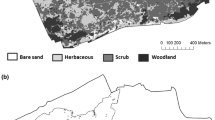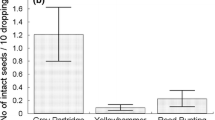Abstract
The potential contribution of vertebrate-mediated seed rain to the maintenance of plant community richness in a High Arctic ecosystem was investigated. We analyzed viable seed content in dung of the four numerically most important terrestrial vertebrates in Northeast Greenland – muskox (Ovibos moschatus), barnacle goose (Branta leucopsis), Arctic fox (Alopex lagopus) and Arctic hare (Lepus arcticus). High numbers of plant propagules were found in the dung of muskox and barnacle goose. Seeds of many plant species were found in the faeces of one vertebrate species only. Propagule composition in barnacle goose droppings was relatively uniform over samples, with a high abundance of the nutritious bulbils of Polygonum viviparum (Bistorta vivipara), suggesting that geese have a narrow habitat preference and feed selectively. Propagule composition in muskox dung was diverse and heterogeneous among samples, suggesting a generalist approach in terms of food selection and the haphazard ingestion of plant propagules with foliage. The species composition of plant propagules in dung samples was different from that of the receiving plant communities (in terms of the Sørensen and Czekanowski dissimilarity indices), and dung deposition, especially by muskox, often brought new species to the receiving community. The results suggest that endozoochorous propagule dispersal in the Arctic has a great potential in the generation and maintenance of local species richness, albeit being little specialized. It is further suggested that endozoochory is an important means of long-distance dispersal and, thereby, of plant migration in response to climate change.




Similar content being viewed by others
References
Adamczewski JZ, Chaplin RK, Schaefer JA, Flood PF (1994) Seasonal variation in intake and digestion of a high-roughage diet by muskoxen. Can J Anim Sci 74:305–313
Alsos IG, Eidesen PB, Ehrich D, Skrede I, Westergaard K, Jacobsen GH, Landvik JY, Taberlet P, Brochmann C (2007) Frequent long-distance plant colonization in the changing Arctic. Science 316:1606–1609
Amarasekare P, Nisbet RM (2001) Spatial heterogeneity, source-sink dynamics, and the local coexistence of competing species. Am Nat 158:572–584
Bay C (1998) Vegetation mapping of Zackenberg valley, Northeast Greenland. Danish Polar Center/Botanical Museum, University of Copenhagen, Copenhagen
Bennike O, Anderson JN (1998) Potamogeton praelongus in West Greenland. Nord J Bot 18:499–501
Berg TB (2004) Mammals. In: Rasch M, Caning K (eds) Zackenberg Ecol Res Operations, 9th Annu Rep 2003. Danish Polar Center, Ministry of Science, Technology and Innovation, Copenhagen, pp 50–56
Böcher TW, Bentzon MW (1958) Density determinations in plant communities. Oikos 9:35–56
Bruun HH, Poschlod P (2006) Why are small seeds dispersed through animal guts: large numbers or seed size per se? Oikos 113:402–411
Bruun HH, Österdahl S, Moen J, Angerbjörn A (2005) Distinct patterns in alpine vegetation around dens of the Arctic fox. Ecography 28:81–87
Buchsbaum R, Wilson J, Valiela I (1986) Digestibility of plant constituents by Canada geese and Atlantic brant. Ecology 67:386–393
Calviño-Cancela M (2002) Spatial patterns of seed dispersal and seedling recruitment in Corema album (Empetraceae): the importance of unspecialized dispersers for regeneration. J Ecol 90:775–784
Chang ER, Zozaya EL, Kuijper DPJ, Bakker JP (2005) Seed dispersal by small herbivores and tidal water: are they important filters in the assembly of salt-marsh communities? Funct Ecol 19:665–673
Charalambidou I, Santamaría L (2002) Waterbirds as endozoochorous dispersers of aquatic organisms: a review of experimental evidence. Acta Oecol 23:165–176
Christiansen HH, Humlum O (1993) Glacial history and periglacial landforms of the Zackenberg area, Northeast Greenland: preliminary results. Dan J Geogr 93:19–29
Clark JS, Silman M, Kern R, Macklin E, Hille Ris Lambers J (1999) Seed dispersal near and far: patterns across temperate and tropical forests. Ecology 80:1475–1494
Clausen P, Nolet BA, Fox AD, Klaassen M (2002) Long-distance endozoochorous dispersal of submerged macrophyte seeds by migratory waterbirds in northern Europe: a critical review of possibilities and limitations. Acta Oecol 23:191–203
Cosyns E, Delporte A, Lens L, Hoffmann M (2005) Germination success of temperate grassland species after passage through ungulate and rabbit guts. J Ecol 93:353–361
Cosyns E, Bossuyt B, Hoffmann M, Vervaet H, Lens L (2006) Seedling establishment after endozoochory in disturbed and undisturbed grasslands. Basic Appl Ecol 7:360–369
Crawley MJ (2005) Statistics: an introduction using R. Wiley, Chichester
Darwin C (1859) On the origin of species by means of natural selection, or the preservation of favoured races in the struggle for life. John Murray, London
Engeman RM, Sugihara RT, Pank LF, Dusenberry WE (1994) A comparison of plotless density estimators using Monte Carlo simulation. Ecology 75:1769–1779
Figuerola J, Santamaría L, Green AJ, Luque I, Alvarez R, Charalambidou I (2005) Endozoochorous dispersal of aquatic plants: does seed gut passage affect plant performance? Am J Bot 92:696–699
Fredskild B (1998) The vegetation types of Northeast Greenland. A phytosociological study based mainly on material left by Th. Sørensen from the 1931–35 expeditions. MoG Biosci 49:1–84
Fuglei E, Øritsland NA (1999) Seasonal trends in body mass, food intake and resting metabolic rate, and induction of metabolic depression in arctic foxes (Alopex lagopus) at Svalbard. J Comp Physiol B 169:361–369
Graae BJ, Pagh S, Bruun HH (2004) An experimental evaluation of the arctic fox (Alopex lagopus) as a seed disperser. Arct Antarct Alp Res 36:468–473
Greene DF, Calogeropoulos C (2002) Measuring and modelling seed dispersal of terrestrial plants. In: Bullock J, Kenward R, Hails R (eds) Dispersal ecology. Blackwell, London, pp 2–23
Halliday G, Kliim-Nielsen L, Smart IHM (1974) Studies on the flora of the North Blosseville Kyst and the hot springs of Greenland. Medd Grønl 199:1–47
Harper JL (1977) Population biology of plants. Academic, London
Higgins SI, Nathan R, Cain ML (2003) Are long-distance dispersal events in plants usually caused by nonstandard means of dispersal? Ecology 84:1945–1956
Hubbell SP (2001) The unified neutral theory of biodiversity and biogeography. Princeton University Press, Princeton
Kalamees R, Zobel M (2002) The role of the seed bank in gap regeneration in a calcareous grassland community. Ecology 83:1017–1025
Koch L, Haller J (1971) Geological map of east Greenland 72°–76°N. Medd Grønl 183:1–26
Levine JM, Murrell DJ (2003) The community-level consequences of seed dispersal patterns. Annu Rev Ecol Evol Syst 34:549–574
McCune B, Mefford MJ (1997) PC-ORD: multivariate analysis of ecological data, version 3.0. MjM Software Design, Gleneden Beach
Meltofte H (2004) Birds. In: Rasch M, Caning K (eds) Zackenberg Ecol Res Operations, 9th Annu Rep 2003. Danish Polar Center, Ministry of Science, Technology and Innovation, Copenhagen, pp 41–50
Moles AT, Ackerly DD, Tweddle JC, Dickie JB, Smith R, Leishman MR, Mayfield MM, Pitman A, Wood JT, Westoby M (2007) Global patterns in seed size. Glob Ecol Biogeogr 16:109–116
Morisita M (1957) A new method for the estimation of density by the spacing method applicable to non-randomly distributed populations. Physiol Ecol Seiri Seitai 7:134–144
Mouquet N, Loreau M (2003) Community patterns in source–sink metacommunities. Am Nat 162:544–557
Muus B, Salomonsen F, Vibe C (1990) Grønlands fauna: fisk, fugle, pattedyr, 2nd edn. Gyldendal, Copenhagen
Nathan R, Muller-Landau HC (2000) Spatial patterns of seed dispersal, their determinants and consequences for recruitment. Trends Ecol Evol 15:278–285
Nielsen SM, Pedersen V, Klitgaard BB (1994) Arctic fox (Alopex lagopus) dens in the Disko Bay area, West Greenland. Arctic 47:327–333
Olesen JM (1987) Heterostyly, homostyly, and long-distance dispersal of Menyanthes trifoliata to Greenland. Can J Bot 65:1509–1513
Pakeman RJ, Digneffe G, Small JL (2002) Ecological correlates of endozoochory by herbivores. Funct Ecol 16:296–304
Pollard JH (1971) Distance estimators of density in randomly distributed forests. Biometrics 27:991–1002
Prop J, Vulink T (1992) Digestion by Barnacle Geese in the annual cycle: the interplay between retention time and food quality. Funct Ecol 6:180–189
R Development Core Team (2005) R: a language and environment for statistical computing. R Foundation for Statistical Computing, Vienna. Available at: http://www.R-project.org
Ridley HN (1930) The dispersal of plants throughout the world. L. Reeve & Co., Ashford
Russo SE, Portnoy S, Augspurger CK (2006) Incorporating animal behavior into seed dispersal models: implications for seed shadows. Ecology 87:3160–3174
Sigsgaard C, Petersen D, Grøndahl L, Meltofte H, Hinkler J, Hansen BU, Tamstorf M, Friborg T (2004) Zackenberg basic: the climate Basis and GeoBasis programmes. In: Rasch M, Caning K (eds) Zackenberg Ecol Res Operations, 9th Annu Rep 2003. Danish Polar Center; Ministry of Science, Technology and Innovation, Copenhagen, pp 10–31
Skellam JG (1951) Random dispersal in theoretical populations. Biometrika 38:196–218
Sokal RR, Rohlf FJ (1995) Biometry. 3rd edn. W.H. Freeman & Co, New York
Soons MB, Heil GW, Nathan R, Katul GG (2004) Determinants of long-distance seed dispersal by wind in grasslands. Ecology 85:3056–3068
Traveset A (1998) Effect of seed passage through vertebrate frugivores’ guts on germination: a review. Perspect Plant Ecol Evol Syst 1:151–190
Turnbull LA, Crawley MJ, Rees M (2000) Are plant populations seed-limited? A review of seed sowing experiments. Oikos 88:225–238
Turček FJ (1964) Endozoische Verbreitung von Gehölzsamen durch den mitteleuropäischen Feldhasen (Lepus europaeus E.Pall.). Biológia 19:541–549
Watt AS (1947) Pattern and process in the plant community. J Ecol 35:1–22
Westcott DA, Bentrupperbäumer J, Bradford MG, McKeown A (2005) Incorporating patterns of disperser behaviour into models of seed dispersal and its effects on estimated dispersal curves. Oecologia 146:57–67
Willson MF, Traveset A, Sabag C (1997) Geese as frugivores and probable seed-dispersal mutualists. J Field Ornithol 68:144–146
Yu DW, Wilson HB (2001) The competition-colonization trade-off is dead; long live the competition-colonization trade-off. Am Nat 158:49–63
Zobel M, Otsus M, Liira J, Moora M, Möls T (2000) Is small-scale species richness limited by seed availability or microsite availability? Ecology 81:3274–3282
Acknowledgements
The field expedition was made possible through a grant from The Commission for Scientific Research in Greenland. Ruth Bruus Jakobsen is thanked for assisting in sorting the dung samples and Christian Bay for his help with determining plants germinated in the greenhouse. Rasmus Ejrnæs and Jari Oksanen are thanked for statistical help. Permit to work in the National Park of Northeast Greenland was obtained from the Greenland Home Rule Authority through the Danish Polar Center.
Author information
Authors and Affiliations
Corresponding author
Additional information
Communicated by Peter Clarke.
Electronic supplementary material
Below is the link to the electronic supplementary material.
Rights and permissions
About this article
Cite this article
Bruun, H.H., Lundgren, R. & Philipp, M. Enhancement of local species richness in tundra by seed dispersal through guts of muskox and barnacle goose. Oecologia 155, 101–110 (2008). https://doi.org/10.1007/s00442-007-0892-y
Received:
Accepted:
Published:
Issue Date:
DOI: https://doi.org/10.1007/s00442-007-0892-y




